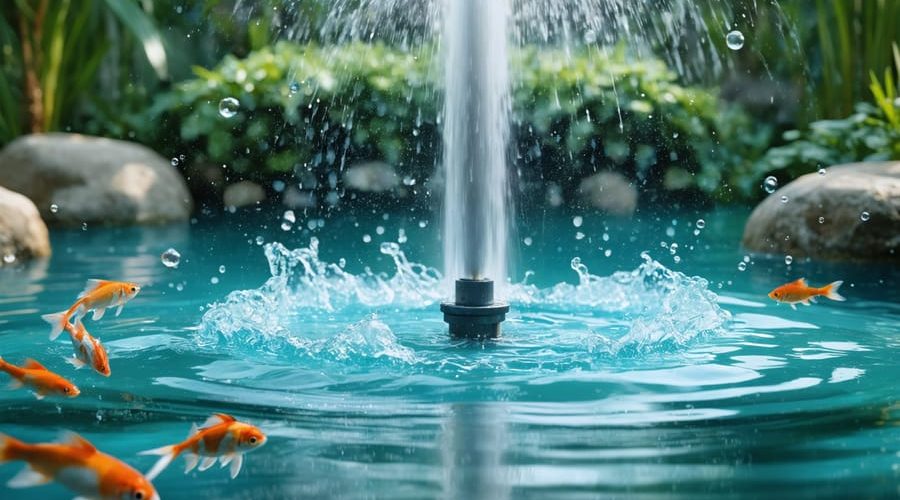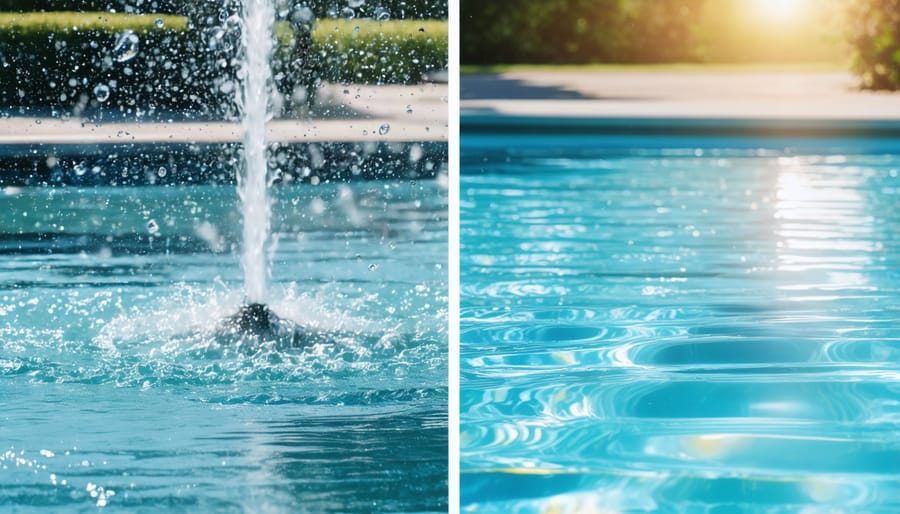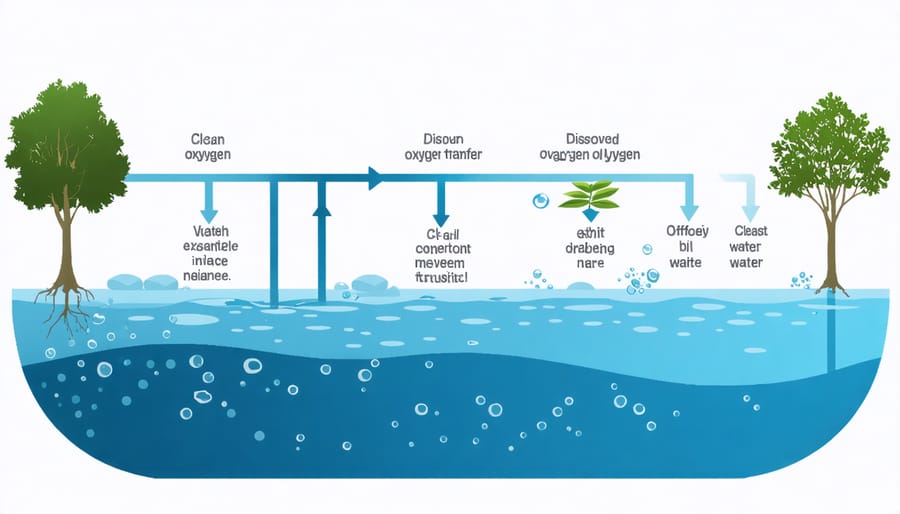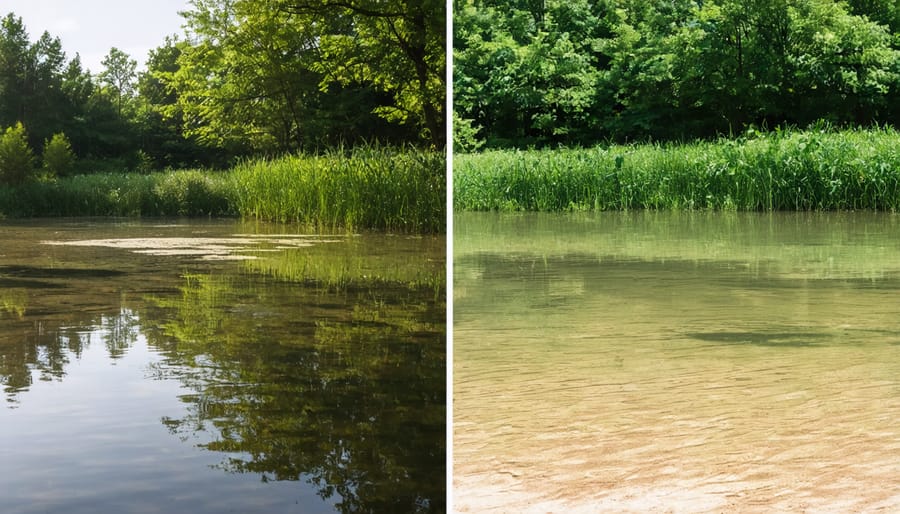
Pond Aerators: The Truth About Their Effectiveness (Real Results)
Pond aerators deliver measurable results backed by decades of scientific research and real-world success. These systems increase dissolved oxygen levels by up to 200%, creating a healthier ecosystem for fish and beneficial bacteria. The benefits of pond aeration are particularly evident in water quality tests, showing reduced algae growth, lower nutrient levels, and clearer water within weeks of installation. For pond owners questioning their investment, the proof lies in consistent temperature readings throughout the water column, increased fish activity, and noticeably improved water clarity. While results vary based on pond size and local conditions, properly sized aerators consistently demonstrate their effectiveness through measurable improvements in water quality parameters and visible ecosystem health.
How Pond Aerators Actually Work
Surface Aerators vs. Bottom Diffusers
When choosing an aerator for your pond, you’ll mainly encounter two types: surface aerators and bottom diffusers. Surface aerators, like fountain-style units, create a beautiful display while spraying water into the air. This process helps oxygen mix with water droplets before they fall back into the pond. They’re great for shallow ponds and add a lovely decorative element to your water feature.
Bottom diffusers, on the other hand, work beneath the surface by releasing tiny bubbles from the pond floor. These bubbles rise through the water column, creating a gentle mixing effect that distributes oxygen throughout deeper areas. While they might not offer the same visual appeal as surface aerators, they’re typically more efficient for deeper ponds and can work alongside natural aeration methods to maintain healthy oxygen levels.
For the best results, consider your pond’s depth and size when choosing between these options. Surface aerators work well in ponds less than 6 feet deep, while bottom diffusers are ideal for deeper waters and larger ponds where thorough circulation is crucial.

The Science of Oxygen Transfer
Think of oxygen transfer like stirring sugar into your tea – the more you stir, the better it dissolves. Pond aerators work on a similar principle. When air bubbles rise through the water, they create contact between air and water, allowing oxygen to dissolve into the pond water.
As bubbles from your aerator travel upward, they do two important things. First, they directly transfer oxygen into the water through their surface. Second, they create a mixing action that brings oxygen-poor bottom water to the surface, where it can pick up more oxygen from the air.
The size of the bubbles matters too. Smaller bubbles are actually more effective because they provide more total surface area for oxygen transfer and stay in the water longer. This is why many modern aerators are designed to produce fine bubbles rather than large ones.
Temperature also plays a role – warm water holds less oxygen than cool water, which is why aeration becomes especially important during hot summer months. The constant movement created by aerators helps maintain healthy oxygen levels even when conditions aren’t ideal.

Measurable Benefits of Pond Aeration
Water Quality Improvements
Research shows that pond aerators significantly improve water quality across multiple parameters. When properly installed, these systems can increase dissolved oxygen levels from as low as 2-3 mg/L to optimal levels of 6-8 mg/L within just a few weeks. This boost in oxygen creates a healthier environment for fish and beneficial bacteria.
The increased circulation helps to control algae growth by disrupting their ability to form dense colonies. Many pond owners report seeing a 50-70% reduction in algae blooms within the first month of running an aerator. The constant movement of water also prevents stagnation and reduces the likelihood of harmful algae taking over your pond.
Water clarity improvements are often dramatic. Users typically notice their pond water becoming clearer within 2-4 weeks of installation, with visibility increasing by several feet in deeper ponds. This clarity isn’t just about aesthetics – it’s a sign that your pond’s ecosystem is becoming more balanced.
Temperature stratification, where warm water sits on top of cold layers, is also eliminated. This mixing helps maintain consistent oxygen levels throughout the pond and prevents the buildup of toxic gases in bottom layers. Many pond owners are amazed to see their fish becoming more active and utilizing the entire pond space rather than staying in specific zones.

Fish Health and Survival Rates
When it comes to fish health, pond aerators make a remarkable difference. Fish require oxygen-rich water to thrive, and an aerator ensures they get exactly that. Pond owners often report seeing their fish become more active and vibrant within days of installing an aerator, especially during warm summer months when oxygen levels typically drop.
Studies show that properly aerated ponds can support up to 30% more fish populations compared to non-aerated ones. This is because oxygen-rich water allows fish to digest food more efficiently, grow faster, and maintain stronger immune systems. During winter months, aerators create ice-free zones that allow harmful gases to escape, preventing winter fish kills.
The benefits extend beyond just fish survival. Higher oxygen levels support beneficial bacteria that break down fish waste and decaying matter, creating a healthier ecosystem overall. These bacteria help maintain water quality and reduce the likelihood of algae blooms that can threaten fish populations.
Many pond owners notice their fish congregating near the aeration zones, especially during hot weather. This behavior indicates that fish naturally seek out oxygen-rich areas where they can breathe more easily. In fact, survival rates during extreme weather conditions can increase by up to 70% in ponds with proper aeration compared to those without.
Remember, healthy fish show signs like active swimming, good appetite, and bright colors – all characteristics commonly observed in well-aerated ponds.
Common Aerator Myths Debunked
Let’s clear up some common misconceptions about pond aerators that might be holding you back from making the best decision for your pond.
First, many people believe that aerators are only necessary for large ponds or lakes. This isn’t true! Even small backyard ponds can benefit significantly from proper aeration. The size of your pond doesn’t determine its need for oxygen – factors like fish population, plant density, and local climate play much bigger roles.
Another widespread myth is that surface agitation alone provides enough oxygen. While ripples and fountains look beautiful and do help with surface oxygen exchange, they don’t address the crucial deeper layers of your pond where oxygen is often needed most. Deep water aeration is especially important during summer months when warm water holds less oxygen.
Some pond owners worry that aerators will disturb the natural ecosystem or stress their fish. Actually, the opposite is true! Fish and beneficial bacteria thrive in oxygen-rich environments. Your pond’s inhabitants will thank you for the improved living conditions.
“Aerators waste electricity” is another common concern we hear. Modern pond aerators are surprisingly energy-efficient, often consuming less power than a typical household light bulb. When you consider the benefits – healthier fish, clearer water, fewer algae problems – the minimal energy cost is well worth it.
Perhaps the most persistent myth is that winter aeration will make your pond too cold. In reality, winter aeration helps prevent total freeze-over by keeping a small area open, allowing harmful gases to escape and maintaining essential oxygen levels for overwintering fish.
Lastly, don’t fall for the myth that aeration is only needed when problems arise. Prevention is always better than cure – regular aeration helps maintain a healthy ecosystem year-round, reducing the likelihood of issues like algae blooms and fish kills before they start.
Getting the Most from Your Pond Aerator
To get the best results from your pond aerator, proper placement is crucial. Position your aerator in the deepest part of your pond, where oxygen levels are typically lowest. If you have a larger pond, consider using multiple aerators or diffusers to ensure even distribution of oxygen throughout the water.
Regular maintenance is key to optimal performance. Clean or replace the air filters every 3-6 months, depending on your environment. Check the air diffuser regularly for clogs or buildup, and clean it gently with a soft brush when needed. During winter months, keep your aerator running to maintain a small ice-free area, which allows for proper gas exchange.
Monitor your aerator’s performance by observing your pond’s ecosystem. Healthy fish actively swimming near the surface, reduced algae growth, and clearer water are all signs your aerator is working effectively. If you notice decreased bubbling or unusual sounds, inspect your system for potential issues.
For maximum efficiency, run your aerator 24/7 during warm months when oxygen demands are highest. In cooler weather, you can reduce operation times, but never completely turn it off unless performing maintenance. Consider installing a timer to automate operation and save energy during cooler periods.
Remember, the size of your aerator should match your pond’s volume and depth. An undersized system won’t provide adequate aeration, while an oversized one wastes energy and may disturb bottom sediments unnecessarily.
In conclusion, pond aerators have proven to be highly effective tools for maintaining healthy aquatic environments. They significantly improve water quality by increasing oxygen levels, reducing algae growth, and preventing stagnation. The benefits are clear: healthier fish, clearer water, reduced maintenance needs, and a more balanced ecosystem overall.
While the initial investment might seem substantial, the long-term advantages far outweigh the costs. From preventing fish kills to reducing bottom muck, aerators tackle multiple pond problems simultaneously. They’re especially valuable during summer months when oxygen levels naturally decrease and during winter to maintain vital gas exchange under ice.
For the best results, choose an appropriately sized aerator for your pond and maintain it regularly. Consider factors like pond depth, surface area, and fish population when selecting your system. Remember that while aerators aren’t magic solutions, they’re essential components of a comprehensive pond management strategy.
If you’re on the fence about installing an aerator, the evidence strongly suggests it’s a worthwhile investment for any pond owner serious about maintaining a healthy, vibrant water feature.
